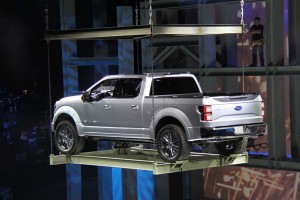
Though Ford's Atlas Concept suggests the next F-Series will make extensive use of aluminum, don't expect steel to go away.
If, as expected, Ford Motor Co. opts to build its next-generation F-Series pickup out of aluminum it will not only shed a tremendous amount of mass but also send a clear signal that the industry is looking for lightweight alternatives as manufacturers struggle to meet tough new mileage and emissions mandates going into effect all over the world.
Most makers are now shifting at least some of their product development efforts to lower mass alternatives, including not only aluminum but magnesium and the still extremely expensive carbon fiber. Yet despite such moves, steel isn’t about to vanish from the automotive toolbox, the head of the nation’s largest producer of the metal insisted.
New alloys and other breakthroughs that he dubbed the “third-generation” of steel will keep the familiar metal in tomorrow’s cars, proclaimed John Surma, CEO of U.S. Steel, during a meeting with the Detroit Automotive Press Association.
Reports of steel’s demise have oft been repeated, he said, noting an article dating back five decades. “It didn’t happen then,” Surma stressed. “It will not happen now.”
That upbeat forecast is clearly subject to challenge in an era when the auto industry is looking for every possible way to meet the 54.5 mpg Corporate Average Fuel Economy mandate set to go into effect in 2025. That is leading to a steady increase in use of hybrid and other battery drive systems, a switch to more advanced transmissions, a renewed focus on wind-cheating aerodynamic designs – and a major emphasis on cutting mass.
The loose rule of thumb is that every 100 pounds cut off the weight of a vehicle yields as much as 1 extra mile per gallon. So, Ford is expecting big savings if it meets a reported target of slashing 750 pounds off the weight of the 2015 F-Series. Land Rover switched to an aluminum-intensive platform and body to cut more than 900 pounds from its latest Ranger Rover.
And for new sports cars, such as the 2014 Jaguar XF and the ’14 Chevrolet Corvette Stingray, reducing weight has the added advantage of improved performance and handling.
A new study by Ducker Worldwide study backed by the European Aluminium Association expects the metal to represent 16% of a typical automobile’s weight by 2025, roughly doubling current levels.
That said, steel isn’t going away, insisted Surma – and automotive industry officials echo that. Indeed, while General Motors has been investing in the development of carbon fiber through its venture capital fund, it has also placed many in Rhode Island-based NanoSteel.
With just 34 employees, the firm is developing a new technique to carefully control the way the microscopic grains in a sheet of steel are aligned. It could be the next giant step in a series of improved steels that permit manufacturers to use thinner sheets of the metal to both trim weight and increase strength.
In his presentation, U.S. Steel’s CEO cited a demonstration project, the FutureSteelVehicle program, that showed how new alloys and updated design methods can reduce the mass of a pre-painted, or body-in-white, by as much as 39% compared to the traditional steel body. The project found that in some cases, steel could match the weight of aluminum suspension components, as well.
“The combinations of scientific research and product development have brought our industry to this point in the development of new steels,” Surma said. “Now, as an industry, we are continuing our research on the next … the third… generation of advanced high-strength steels.”
Ironically, while proponents promote aluminum and other material’s as more environmentally friendly than steel, that’s also a matter of debate. Producing raw aluminum is an extremely extensive process compared to steel, something that arguably wipes out much of the savings in per-mile fuel costs. Recycled aluminum, Jaguar officials noted this week, requires as little as 10% of the energy content of new metal, but with usage rapidly rising, recycling won’t have a huge impact on automotive demand for years to come.
“Steel is an incredibly green material,” added Surma, concluding “Steel can be recycled continuously without affecting its key performance attributes.”
There is little doubt that the familiar metal will yield ground to lighter alternatives in the coming years, but those who expect steel to largely go away have reason to exercise caution, it appears.

Aluminum is a challenge to repair…will aluminum vehicles cause insurance rates to go up? Only certain shops are set up to fix aluminum cars.